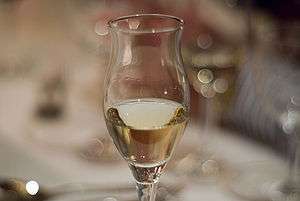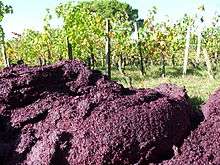Pomace brandy

Pomace brandy, also called marc in both English and French, is a liquor distilled from pomace that is left over from winemaking after the grapes are pressed. Alcohol derived from pomace is also used as the traditional base spirit of other liquors, such as some anise-flavored spirits. Unlike wine brandy, most pomace brandies are neither aged nor coloured.
Production


Pomace may be either fermented, semi-fermented, or unfermented. During red wine vinification, the pomace is left to soak in the must for the entire fermentation period and is thus fermented. Fermented pomace is particularly suitable for the production of pomace brandy, as it is soft, dry, and has a high alcohol content. Semi-fermented pomace is produced during rosé wine vinification, where the pomace is removed before fermentation is complete. Virgin pomace, which is produced during white wine vinification, is not fermented at all.
Both semi-fermented and unfermented pomace must be kept in a silo until fermentation is complete. After fermentation is complete, the pomace is distilled.
Varieties

Varieties of pomace brandy include:
- Albanian Raki e Rushi
- Bulgarian джиброва
- Bolivian Singani
- Bosnian, Croatian, Serbian and Montenegrin komovica
- Macedonian комова
- Cretan tsikoudia
- Cypriot zivania
- French marc
- Georgian chacha
- German Tresterbrand
- Greek tsipouro
- Hungarian törkölypálinka
- Italian grappa
- Lebanese / Palestinian / Syrian araq
- Mexican Presidente
- Portuguese aguardente, Bagaceira
- Peruvian / Chilean Pisco[1]
- Romanian tescovină
- Russian Kislyarka
- Slovak terkelica
- Slovene Tropinovec
- Spanish orujo
References
- ↑ Ray Foley (2011). The Ultimate Little Cocktail Book. Sourcebooks, Inc. Retrieved 9 July 2014.


